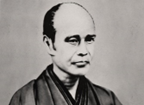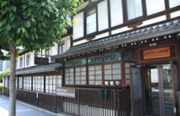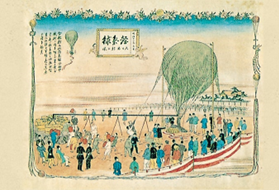Spring in Kyoto, “Miyako Odori” and the Modernization of Kyoto II
Yoshie Doi
 Genzo Shimadzu |
 Shimadzu Foundation Memorial Museum |

The situation to fly a balloon at Kyoto Gyoen |
When I pass in front of a teahouse in Gion, I sometimes hear the sound of the shamisen and stop walking. My daughter, who was in elementary school, suddenly said, “I want to learn shamisen,” and the two of us went to practice together. She has a good sense of pitch and can play just by picking up the sound without looking at the piano or sheet music. I was tone deaf and had a poor sense of pitch, so I was not able to improve. Our teacher took a day off due to illness, so we stopped taking lessons, but our teacher always had told me, “Mom, your daughter is improving.”
I think that the atmosphere of the Miyako Odori with the sound of the shamisen represents the echo of one of the cultures of Kyoto.It’s comfortable and relaxing. Miyako Odori has been a favorite since my daughter was in kindergarten. Even after the performance ended, she insisted that she would not go home, and after that, we watched it from a standing room.
When we visited the Takarazuka Revue, my daughter, who was in kindergarten, said five minutes after the start of the performance, “I want to go home.” She must have had culture shock. When we live in Kyoto, does the sound of the shamisen, the Gion music, the sound of the bell, etc., become part of your genes!
I feel the sensation of the genes of the Millennium Capital coming through my skin along with the memories of the land and culture. The exquisite balance between traditional performing arts and the evolution of modern industrial technology is due to the fact that craftsmen in Kyoto acquire skills through the formula of “learn by seeing, learning by hearing, and learning by watching”. Was life itself a form of training!
The difference between a master and an expert is to pursue the ultimate, and it seems that there were many such masters in Kyoto during the Meiji period.
In the first year of the Meiji Restoration, the Boshin War destroyed everything, and the emperor was relocated to Tokyo.The people of Kyoto were burning with the desire to create a new world on their own.
The Kyoto Seimikyoku was established in 1870 near the present-day The Ritz-Carlton Kyoto in Nijo on the Kamogawa River, promoting the modernization of Japan. Genzo Shimadzu was a metal processing craftsman for Buddhist altar fittings. The Kyoto Seimikyoku was built right in front of his eyes, and he always went to see what it was like, and received requests for repairs.
It is said that Genzo Shimadzu met the German engineer Dr. Wagner and the Dutch engineer Dr. Heertz, and asked questions to Japanese engineers, etc., and devised them himself.
From Dr. Wagner, he learned how to make physics and chemistry equipment and how to operate a German foot-operated wooden lathe. Shimadzu Genzo mastered the technique by asking questions such as “How is it made?” and “What is the structure?” After that, he was able to provide physics and chemistry equipment to elementary and junior high schools. Completed by research from scratch.
The fact that Genzo Shimadzu, who spearheaded the modernization of Kyoto, came from the traditional industry of a Buddhist altar fittings dealer is also an episode typical of Kyoto.
It can be imagined that Genzo Shimadzu, who was a Buddhist altar fittings dealer and was good at fine craftsmanship, rapidly mastered cutting-edge technology. Then, on December 6, 1877, in the presence of 50,000 spectators at Kyoto Gyoen, he made Japan’s first manned light balloon flight to an altitude of 36 meters, achieving a great feat. It is said that hydrogen was used, and scrap iron was put into 10 four-to-barrels of Fushimi sake, diluted sulfuric acid was poured in, and a large amount of hydrogen was generated and blown away. is exhibited in No matter how many times I see it, I am impressed.
Also, the entrance fee for the manned flight at Kyoto Gyoen was 3 sen (One sen is equivalent to the current 200 yen, and the entrance fee is 600 yen.) per person and half price for children, and he received half the entrance fee, and used the proceeds for the next research fund.
Just as the stage of the Miyako Odori, which pioneered modern industry, was lit up and made history as the first stage in Japan to be lit up, we would like to revitalize Kyoto with the spirit of recreating a new world.
The end of document
